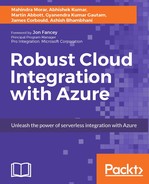Through this book, we have looked at the state of integration in Microsoft Azure. We have talked in depth about Logic Apps and discussed how we are moving to an increasingly connected world with IoT Hubs. We have looked at how we can leverage the huge investment in on-premises line of business applications by linking them with the cloud through the newest version of Microsoft's tried and tested integration platform, BizTalk Server 2016. By introducing BizTalk Server 2016, we have shown how to get the best of both worlds, on-premises security and business critical systems with cloud-based security, commodity, and scale.
On this journey, we have introduced our fictional company, Sunny Electricals, to help deliver the key messages about the how and why to use the array of options available in cloud integration with Microsoft Azure.
The pace of change for cloud computing in general, and Microsoft Azure specifically, means that this is a great time to be involved in solving technology problems with hybrid integration solutions.
Given this pace of change, it is as important to look at the horizon and see what is either just visible or may be coming soon.
This chapter gives an overview of what is coming next within the integration domain and in cloud-based services. It discusses Microsoft's integration roadmap and the industry trends that are driving transformation in the integration space. It examines how we can build integration solutions today that can support these future trends and, at the same time, remain relevant in a few years, by remembering the lessons from the past to build the next generation of successful applications.
- Microsoft's integration roadmap for on-premises and the cloud
- Lessons from the past and how they apply to building integration solutions today
- Introduction to PowerApps
- Introduction to Microsoft Flow
Here are the skills to be learned:
- How to navigate the maze of options to create applications that support extensibility and can cater for future trends and ideas
- Identifying currently available technologies in Azure and how they can be used in conjunction with one another to build a solution
- Understanding the past to build the solution of the future
- What factors should influence a design to provide a level of future proofing
This book has introduced many technologies that affect the integration landscape of cloud computing, from API Management and Logic Apps to Azure Functions, BizTalk Server, and IoT Hubs. The current range of integration technologies is broad in reach and supports workloads in the cloud, on-premises, and between both.
None of us have a crystal ball, but it is possible to take a short look into the future and speculate on some of the ways these technologies may evolve:
- Microservices: So far, microservices have had only a limited impact in the enterprise, but it is safe to assume that they will become the new way to build agile and scalable integrated solutions of the future.
- Azure Service Fabric: This platform service is the basis for many other platform services, and it provides a good platform for highly scalable, highly distributed solutions. It supports both stateful and stateless applications as well as an ability to provide resilience and rolling updates. For more information, see https://azure.microsoft.com/en-us/services/service-fabric/.
- Logic Apps: The rate of change of Logic Apps since becoming generally available has been huge, and we can expect more connectors, more flow control, and more BizTalk-like capabilities built into the service. It has been indicated that Logic Apps will be the place where initial feature releases are made before they are moved to the core on-premises solution with BizTalk Server.
- Azure Stack: This data center for the masses solution provides a lot of core Azure features that can be run within your own data center, including Azure App Services. For more information, see https://azure.microsoft.com/en-us/overview/azure-stack/.
- Azure Functions: Since reaching general availability, it can be expected that additional language support and tooling will continue to make appearances in the core service.
Although integration is a key technology, it cannot be a technology in isolation and should deliver value to the business.
